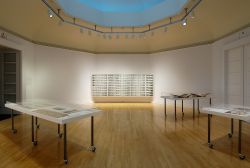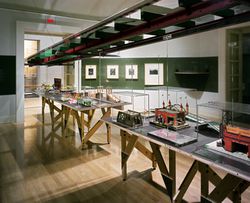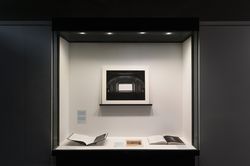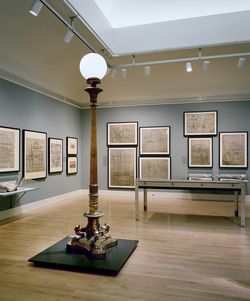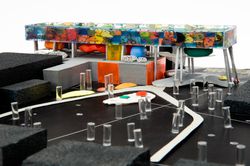archives
Level of archival description:
Fonds
Joseph Rykwert fonds
AP209
Synopsis:
The Joseph Rykwert fonds, 1928-2022, documents Joseph Rykwert’s career as an architectural historian, author and professor. The fonds includes the records for over a dozen monographs written between the mid-1960s and the mid-2010s as well as edited works and articles, and details his teaching and lecturing activities from the 1960s onwards in universities in Europe and the United States. The records highlight Joseph Rykwert’s multidisciplinary approach, which involved archaeology, anthropology and psychoanalysis in his study of the history and theory of architecture and of the urban form. The fonds is composed of textual records, publications and ephemera, and of photographs including multiple albums and a large number of slides; the fonds also documents Joseph Rykwert’s career as an independent designer through drawings realized between the late 1940s and the late 1970s.
1928-2022
Joseph Rykwert fonds
Actions:
AP209
Synopsis:
The Joseph Rykwert fonds, 1928-2022, documents Joseph Rykwert’s career as an architectural historian, author and professor. The fonds includes the records for over a dozen monographs written between the mid-1960s and the mid-2010s as well as edited works and articles, and details his teaching and lecturing activities from the 1960s onwards in universities in Europe and the United States. The records highlight Joseph Rykwert’s multidisciplinary approach, which involved archaeology, anthropology and psychoanalysis in his study of the history and theory of architecture and of the urban form. The fonds is composed of textual records, publications and ephemera, and of photographs including multiple albums and a large number of slides; the fonds also documents Joseph Rykwert’s career as an independent designer through drawings realized between the late 1940s and the late 1970s.
archives
Level of archival description:
Fonds
1928-2022
textual records
DR2021:0052:001-039
Description:
The papers in this collection are related to the participation of Barry Campbell in a project to create a 1:50 scale model for the Maison d'Artiste, an unbuilt project designed by architects Theo van Doesburg and Cor van Eesteren in 1923. The model, sponsored by lawyer Piet Sanders and Barry Campbell, was made by Frans Postma and was exhibited at the Stedelijk Museum De Lakenhal (2009-2010) and the Tate Modern (2010) as part of the exhibition "Van Doesburg and the International Avant Garde: Constructing a New World". In 2013, Barry Campbell, Frans Postma and Victor Veldhuijzen van Zanten donated the 1:50 model to Het Nieuwe Instituut/The New Institute in Rotterdam, the Netherlands (Piet Sanders, who died in September, 2012, was also named as a donor). A 1:75 scale model was made for each of the donors. Textual records in the collection include correspondence, a copy of the donor agreement, and a text by Bertus Mulder. Drawings include printouts of plans, elevations, sections, and perspectives. There are also photographs of drawings. Digital files consist of a panorama by Postma & Partner. The collection includes a printout of a photograph of Barry Campbell with the 1:50 model.
2007-2013
Barry Campbell papers related to a 1:50 scale model for the Maison d'Artiste
Actions:
DR2021:0052:001-039
Description:
The papers in this collection are related to the participation of Barry Campbell in a project to create a 1:50 scale model for the Maison d'Artiste, an unbuilt project designed by architects Theo van Doesburg and Cor van Eesteren in 1923. The model, sponsored by lawyer Piet Sanders and Barry Campbell, was made by Frans Postma and was exhibited at the Stedelijk Museum De Lakenhal (2009-2010) and the Tate Modern (2010) as part of the exhibition "Van Doesburg and the International Avant Garde: Constructing a New World". In 2013, Barry Campbell, Frans Postma and Victor Veldhuijzen van Zanten donated the 1:50 model to Het Nieuwe Instituut/The New Institute in Rotterdam, the Netherlands (Piet Sanders, who died in September, 2012, was also named as a donor). A 1:75 scale model was made for each of the donors. Textual records in the collection include correspondence, a copy of the donor agreement, and a text by Bertus Mulder. Drawings include printouts of plans, elevations, sections, and perspectives. There are also photographs of drawings. Digital files consist of a panorama by Postma & Partner. The collection includes a printout of a photograph of Barry Campbell with the 1:50 model.
textual records
2007-2013
According to a Chinese legend well-known in Japan, a giant katsura tree was planted on the moon, inspiring the proverb, “We can see the katsura on the moon with our eyes, but we cannot touch it with our hands.” The saying celebrates the quest for an absolute and is a fitting epigraph for Departure for Katsura, which pursues issues of self-identity and personal(...)
Octagonal gallery, hall cases, and Sottsass Room
9 December 1998 to 28 March 1999
Irene F. Whittome: Departure for Katsura
Actions:
Description:
According to a Chinese legend well-known in Japan, a giant katsura tree was planted on the moon, inspiring the proverb, “We can see the katsura on the moon with our eyes, but we cannot touch it with our hands.” The saying celebrates the quest for an absolute and is a fitting epigraph for Departure for Katsura, which pursues issues of self-identity and personal(...)
Octagonal gallery, hall cases, and Sottsass Room
Project
AP207.S1.1971.PR04
Description:
This project series documents Pettena's performance "Vestirsi Di Siede", also know in English as "Wearable Chairs". The performance was carried out between 3 pm and 5 pm on February 12, 1971, in the streets of Minneapolis by ten students of Pettena at the Minneapolis College of Art and Design. The students, each wearing a portable chair harnessed on their back, wandered around the city, either by foot or by bus, and than returned to the college. "In this performance, it was the body that activated and gave meaning to the object: the chair only taking on meaning when carried, otherwise, it became disjointed." [1] The chairs were then put on display at the Minneapolis Institute of Art. A second edition of the performance was also carried out with the students from Nuova Accademia di Belle Arti (NABA) in Milan, 2011, and an installation of the chairs was presented at the exhibition "Un art pauvre" at the Centre Pompidou in 2016. The project series contains photographs of the performance by the students of the Minneapolis College of Art and Design and photographs of the exhibit at the Minneapolis Institute of Art in 1971. It also contains three sketches for the chairs, a drawing of the performance and a statement about the perfomance. The project series also includes photographs of the performance of the NABA students in 2011. Source: [1] FRAC Centre-Val de Loire, http://www.frac-centre.fr/_en/art-and-architecture-collection/pettena-gianni/wearable-chairs-verstirsi-siede-317.html?authID=148&ensembleID=1286 (last accessed 11 November 2019)
1971-2017
Vestirsi Di Siede [Wearable Chairs] (1971)
Actions:
AP207.S1.1971.PR04
Description:
This project series documents Pettena's performance "Vestirsi Di Siede", also know in English as "Wearable Chairs". The performance was carried out between 3 pm and 5 pm on February 12, 1971, in the streets of Minneapolis by ten students of Pettena at the Minneapolis College of Art and Design. The students, each wearing a portable chair harnessed on their back, wandered around the city, either by foot or by bus, and than returned to the college. "In this performance, it was the body that activated and gave meaning to the object: the chair only taking on meaning when carried, otherwise, it became disjointed." [1] The chairs were then put on display at the Minneapolis Institute of Art. A second edition of the performance was also carried out with the students from Nuova Accademia di Belle Arti (NABA) in Milan, 2011, and an installation of the chairs was presented at the exhibition "Un art pauvre" at the Centre Pompidou in 2016. The project series contains photographs of the performance by the students of the Minneapolis College of Art and Design and photographs of the exhibit at the Minneapolis Institute of Art in 1971. It also contains three sketches for the chairs, a drawing of the performance and a statement about the perfomance. The project series also includes photographs of the performance of the NABA students in 2011. Source: [1] FRAC Centre-Val de Loire, http://www.frac-centre.fr/_en/art-and-architecture-collection/pettena-gianni/wearable-chairs-verstirsi-siede-317.html?authID=148&ensembleID=1286 (last accessed 11 November 2019)
Project
1971-2017
German artist Dieter Appelt presents a major work commissioned by the CCA and inspired by the late nineteenth-century Forth Rail Bridge near Edinburgh, Scotland. Dieter Appelt: Forth Bridge — Cinema. Metric Space is the second of four exhibitions in the Tangent series, which brings contemporary artists into dialogue with the CCA Collection and results in newly(...)
Octagonal gallery
9 March 2005 to 22 May 2005
Dieter Appelt: Forth Bridge - Cinema. Metric Space
Actions:
Description:
German artist Dieter Appelt presents a major work commissioned by the CCA and inspired by the late nineteenth-century Forth Rail Bridge near Edinburgh, Scotland. Dieter Appelt: Forth Bridge — Cinema. Metric Space is the second of four exhibitions in the Tangent series, which brings contemporary artists into dialogue with the CCA Collection and results in newly(...)
Octagonal gallery
Toys and Transport
Every new transportation link and every change in systems of urban mobility introduces new infrastructure to the urban landscape: massive cuts enabling railway tracks to converge at a terminal or junction; wide railyards that service suburban and metropolitan transit systems; the proliferation of bridges, ramps, elevated highways, freeway cuts, parking lots, and even(...)
Octagonal gallery
15 November 2000 to 1 April 2001
Toys and Transport
Actions:
Description:
Every new transportation link and every change in systems of urban mobility introduces new infrastructure to the urban landscape: massive cuts enabling railway tracks to converge at a terminal or junction; wide railyards that service suburban and metropolitan transit systems; the proliferation of bridges, ramps, elevated highways, freeway cuts, parking lots, and even(...)
Octagonal gallery
Series
CD041.S2
Description:
This series documents nine projects by the firm Rosen, Caruso, Vecsei Architects. The practice was opened in partnership by Bernard Rosen, Irving Caruso and André Vecsei. The latter was partner until his departure in 1984 when he founded Vecsei Architects with Eva Hollo Vecsei. During his time at Rosen, Caruso, Vecsei Architect, André was the partner in charge of several projects including: Twenty-five story apartment building, Lincoln Avenue and St. Mathieu Street, Montréal, Québec (circa 1962-1974); Nursing home, Côte-Saint-Luc, Québec (circa 1962-1970); Senoir’s home, Manoir Outremont, Outremont, Québec (1977); Intermunicipal library, Pierrefonds, Montréal, Québec (circa 1980-1984). Eva Hollo Vecsei did not work for the firm Rosen, Caruso, Vecsei Architects. This series documents the following projects: Golf clubhouse, Mirabel, Québec (circa 1962-1970); Fraternity house, Montréal, Québec (circa 1964); Marina, Expo 67, Montréal, Québec (1965-1966); Engineering Institute of Canada, Montréal, Québec (circa 1967); International Civil Aviation Organisation building, Montréal, Québec (circa 1974); Seniors home, Manoir Outremont, Outremont, Québec (1977); Fort de la Montagne, Westmount, Québec (circa 1980-1982); and City hall and municipal library, Côte-Saint-Luc, Québec (circa 1981-1984). Also included are sketches from 1962 to 1984 for an unidentified project. Collection material in this series was produced between 1974 and 2006. Documenting the series are architectural records, such as conceptual, design, presentation, and working drawings, as well as photographs, digital material (mainly photographs), and a sketchbook. The bulk of the material was produced between 1981 and 1984, which corresponds to the period during which André Vecsei worked on the city hall and municipal library, in Côte-Saint-Luc, Québec. Documenting this project are working drawings and a few digitized sketches and photographs.
1974-2006
Rosen, Caruso, Vecsei Architects (1962-1984)
Actions:
CD041.S2
Description:
This series documents nine projects by the firm Rosen, Caruso, Vecsei Architects. The practice was opened in partnership by Bernard Rosen, Irving Caruso and André Vecsei. The latter was partner until his departure in 1984 when he founded Vecsei Architects with Eva Hollo Vecsei. During his time at Rosen, Caruso, Vecsei Architect, André was the partner in charge of several projects including: Twenty-five story apartment building, Lincoln Avenue and St. Mathieu Street, Montréal, Québec (circa 1962-1974); Nursing home, Côte-Saint-Luc, Québec (circa 1962-1970); Senoir’s home, Manoir Outremont, Outremont, Québec (1977); Intermunicipal library, Pierrefonds, Montréal, Québec (circa 1980-1984). Eva Hollo Vecsei did not work for the firm Rosen, Caruso, Vecsei Architects. This series documents the following projects: Golf clubhouse, Mirabel, Québec (circa 1962-1970); Fraternity house, Montréal, Québec (circa 1964); Marina, Expo 67, Montréal, Québec (1965-1966); Engineering Institute of Canada, Montréal, Québec (circa 1967); International Civil Aviation Organisation building, Montréal, Québec (circa 1974); Seniors home, Manoir Outremont, Outremont, Québec (1977); Fort de la Montagne, Westmount, Québec (circa 1980-1982); and City hall and municipal library, Côte-Saint-Luc, Québec (circa 1981-1984). Also included are sketches from 1962 to 1984 for an unidentified project. Collection material in this series was produced between 1974 and 2006. Documenting the series are architectural records, such as conceptual, design, presentation, and working drawings, as well as photographs, digital material (mainly photographs), and a sketchbook. The bulk of the material was produced between 1981 and 1984, which corresponds to the period during which André Vecsei worked on the city hall and municipal library, in Côte-Saint-Luc, Québec. Documenting this project are working drawings and a few digitized sketches and photographs.
Series
1974-2006
Mirrors / Miroirs
Mirrors/ Miroirs is conceived through an indirect dialogue with the exhibition Besides, History: Go Hasegawa, Kersten Geers, David Van Severen, a project rooted in the shared references and resonances between the work of two contemporary practices in the presence of history. If Besides, History is premised on impressions of one office’s work registered through(...)
Hall cases
22 June 2017 to 14 January 2018
Mirrors / Miroirs
Actions:
Description:
Mirrors/ Miroirs is conceived through an indirect dialogue with the exhibition Besides, History: Go Hasegawa, Kersten Geers, David Van Severen, a project rooted in the shared references and resonances between the work of two contemporary practices in the presence of history. If Besides, History is premised on impressions of one office’s work registered through(...)
Hall cases
This exhibition looks at the transformation of Montréal from a nineteenth century merchant city to the metropolis of Canada. It examines the elements that made Montréal a political, social, and economic centre and explores the unique character of its architecture. The exhibition brings together some 350 objects, including drawings from the CCA collection by Montréal(...)
Main galleries
18 March 1998 to 24 May 1998
Montréal Métropole, 1880–1930
Actions:
Description:
This exhibition looks at the transformation of Montréal from a nineteenth century merchant city to the metropolis of Canada. It examines the elements that made Montréal a political, social, and economic centre and explores the unique character of its architecture. The exhibition brings together some 350 objects, including drawings from the CCA collection by Montréal(...)
Main galleries
This exhibition features British architect Will Alsop’s preparatory work for the Sharp Centre for Design at the Ontario College of Art Design (OCAD) in Toronto and explores the role of painting in his design process. Completed in 2004, OCAD’s Sharp Centre for Design was designed by Alsop Architects in collaboration with the Toronto-based firm Robbie/Young + Wright. The(...)
Octagonal gallery
13 June 2008 to 5 October 2008
Will Alsop: OCAD, An Urban Manifesto
Actions:
Description:
This exhibition features British architect Will Alsop’s preparatory work for the Sharp Centre for Design at the Ontario College of Art Design (OCAD) in Toronto and explores the role of painting in his design process. Completed in 2004, OCAD’s Sharp Centre for Design was designed by Alsop Architects in collaboration with the Toronto-based firm Robbie/Young + Wright. The(...)
Octagonal gallery

